Drums are not only instruments of rhythm but also visual statements that reflect the personality and style of the musician. When it comes to enhancing the appearance of drum kits, two popular options are lacquer finishes and drum wraps. Each choice offers distinct visual and acoustic qualities that cater to different preferences and musical genres. In this article, we’ll explore the differences between lacquer and wrap finishes for drums, shedding light on their aesthetic and acoustic characteristics.
Lacquer Drum Finishes
Lacquer finishes involve applying layers of lacquer paint directly to the drum shell, resulting in a smooth, glossy, and vibrant surface. Lacquer finishes are known for their durability and ability to showcase the natural wood grain, adding depth and character to the drums.
Aesthetic Characteristics:
- Natural Elegance: Lacquer finishes highlight the natural beauty of the drum shell’s wood grain, enhancing the instrument’s organic appeal.
- Glossy Shine: The glossy surface of lacquer finishes catches and reflects light, creating a polished and eye-catching appearance on stage.
- Customization: Lacquer finishes can be customized with various colors, allowing drummers to create unique and personalized aesthetics.
Acoustic Characteristics:
- Sound Projection: Lacquer finishes are generally considered to have a minimal impact on the drum’s sound projection and resonance, preserving the drum’s natural tone.
- Depth of Tone: The natural wood properties of the drum shell are often more pronounced with a lacquer finish, contributing to a rich and well-defined tone.
Drum Wrap Finishes
Drum wraps involve applying a vinyl or fabric material to the drum shell’s exterior, providing a wide range of visual possibilities. Wraps can mimic various textures, patterns, and colors, making them a versatile choice for customization.
Aesthetic Characteristics:
- Versatility: Drum wraps offer endless design options, from solid colors to intricate patterns, textures, and even images.
- Visual Impact: Wraps can create bold and eye-catching designs that stand out on stage and make a strong visual statement.
- Consistency: Drum wraps provide a uniform appearance across the entire drum kit, creating a cohesive and polished look.
Acoustic Characteristics:
- Minimal Impact: Drum wraps generally have a minimal effect on the drum’s acoustic properties, allowing the natural sound of the drum shell to shine through.
- Texture Influence: Some wraps may have a subtle influence on the drum’s texture, which could result in minor changes to the drum’s sound characteristics.
Choosing Between Lacquer and Wrap
- Aesthetic Preference: The choice between lacquer and wrap often comes down to personal aesthetic preferences. Lacquer emphasizes the natural wood beauty, while wraps offer a wide range of design possibilities.
- Musical Genre: Consider the genre of music you primarily play. Lacquer finishes are well-suited for genres that value classic elegance, while wraps allow for creative expression in various styles.
- Durability: Lacquer finishes are generally more durable and resistant to wear and tear compared to wraps, which may be prone to chipping or peeling over time.
Conclusion
Lacquer finishes and drum wraps are both fantastic options for customizing the appearance of drum kits, offering distinct visual and acoustic characteristics. Whether you’re drawn to the natural elegance of lacquer finishes or the creative potential of drum wraps, both choices allow drummers to express their individuality and style through their instruments. Understanding the differences between these two options empowers drummers to make an informed decision that aligns with their preferences, musical genre, and desire for visual impact.

